Range 3,338 km Engine type Turboprop | Length 13 m | |
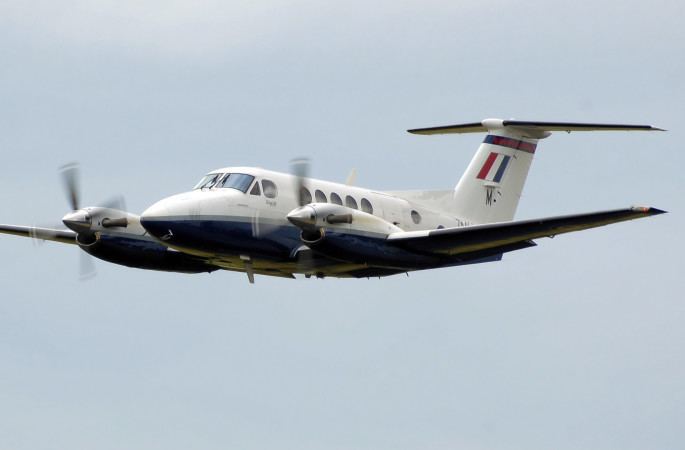 | ||
Unit cost 5,240,000–7,570,000 USD (2009) | ||
Beechcraft super king air 350 engine startup and takeoff
The Beechcraft Super King Air family is part of a line of twin-turboprop aircraft produced by Beechcraft. The King Air line comprises a number of model series that fall into four families: the Model 90 series, Model 100 series (these models comprising the King Air family), Model 200 series and Model 300 series. The latter two models were originally marketed as the "Super King Air" family, but the "Super" was dropped in 1996.
Contents
- Beechcraft super king air 350 engine startup and takeoff
- Super King Air 200
- Model 200 military variants
- PD 290
- Super King Air 300350
- Model 300 military variants
- Modification and upgrade programs
- Operational history
- Variants
- Operators
- Military operators
- Former operators
- Civil operators
- Accidents and incidents
- Specifications King Air B200
- References

The Super King Air family has been in continuous production since 1974, the longest production run of any civilian turboprop aircraft in its class. It has outlasted all of its previous competitors and as of 2009 the only other aircraft in its class is the Piaggio P.180 Avanti. At the present, the B200GT, B200CGT and the larger B300 and B300C are the production models. Special mission derivative versions of these models are also available for order.
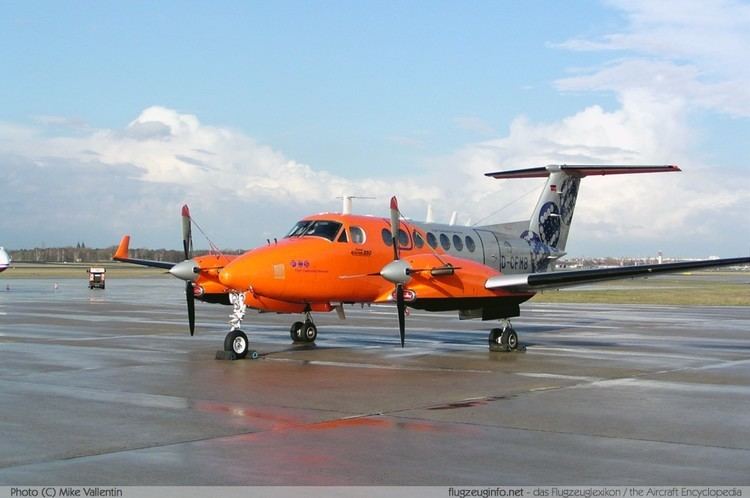
The Beechcraft 1900 regional airliner was derived from the Model B200 King Air.
Super King Air 200
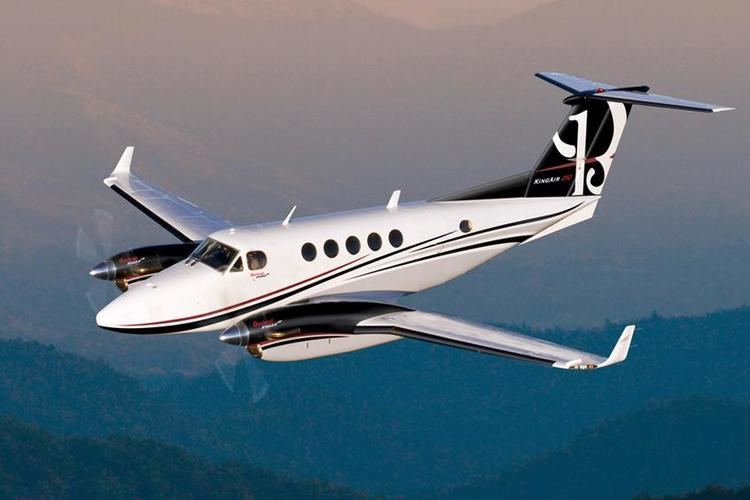
The Model 200 was originally conceived as the Model 101 in 1969, and was a development of the Model 100 King Air. The Model 200 had essentially the same fuselage as the Model 100, with changes to the rear fuselage to accommodate a new T-tail (in place of the 100's conventional tail with all-moving trimmable horizontal stabilizer) and structural changes to allow higher maximum pressurization. Apart from the T-tail, other changes included Pratt & Whitney Canada PT6A-41 engines rated at 1,015 shp (757 kW) instead of the 805 shp (600 kW) engines of the Model A100 then in production, and a wing of increased span and extra fuel capacity. Overall, the 200 was 3 ft 10 in (1.17 m) longer than the A100, with wingspan 4 ft 3 in (1.29 m) greater, containing 60 US gallons (230 L) more fuel. Maximum Take-Off Weight (MTOW) was increased by 1,000 lb (450 kg). After protracted development including extensive wind tunnel testing of the design (especially of the T-tail which was tunnel-tested for 375 hours), the first prototype flew for the first time on October 27, 1972; a second prototype took to the air on December 15 the same year. Three production aircraft were also built in 1972 and delivered to the U.S. Army; these three were designated Model A100-1s by Beechcraft and were given the military designation RU-21J; the first of some 400 T-tail King Airs to be ordered by the U.S. armed forces. The 200 received civil certification in December 1973 and the first civil delivery took place in February 1974.

In 1976, Beechcraft developed the Model 200T, a version configured for aerial surveying or reconnaissance. The prototype was created by modifying a Model 200 aircraft, constructor's number (c/no.) BB-186; the modifications included changes to the belly aft of the wing to allow photography with a vertical camera, provision for a surveillance radar in a pod under the fuselage, dome-shaped windows on the sides of the rear fuselage to allow observation directly below the aircraft by occupants, and a 50-US-gallon (190 L) usable capacity fuel tank on each wingtip to increase the aircraft's range. Customers could specify any combination of these modifications when ordering a 200T; all 200Ts were Model 200s modified at the factory and given new constructor's numbers.
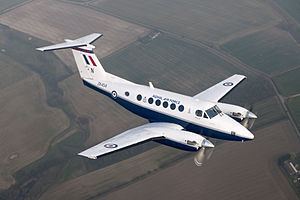
The next model to appear was the Model 200C in 1979; this version had a large cargo door on the LH side of the rear fuselage with an airstair door similar to the Model 200's door built into it. The door opening was 4 ft 4 in (1.33 m) high and 4 ft 4 in (1.33 m) wide, allowing a large range of items to be loaded into the cabin. The Model 200C found favour with many operators who fitted them out internally as Air Ambulances. The 200C was built from scratch rather than as a modification of the Model 200. The Model A200C military version was developed concurrently. In 1981, a Model 200C (c/no. BL-24) was modified as the Model 200CT, fitted with the same wingtip fuel tanks as installed on Model 200Ts; there was only one 200CT, but it led to other aircraft after an updated version of the Model 200 entered production.
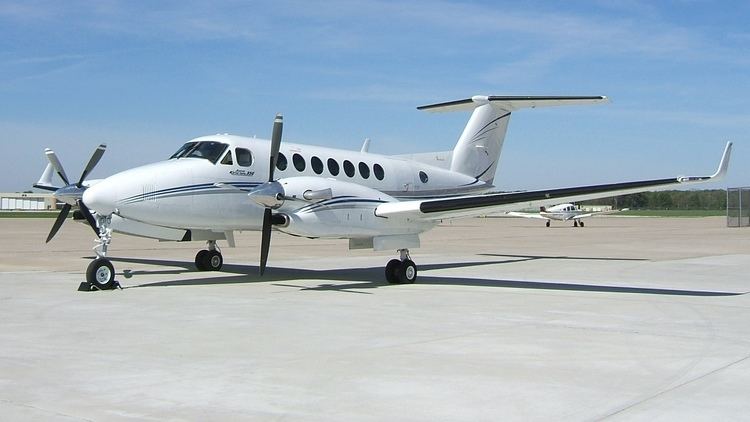
This updated and improved version was the Model B200, which entered production in 1981. It was fitted with PT6A-42 engines, still rated at 850 shp (630 kW), but with improvements that resulted in greater aircraft performance. Other changes included increased maximum pressurization (to 6.5 psi differential) and changes to the cockpit layout. The Model 200C gave way to the Model B200C the same year, with the first Model B200T and Model B200CT being modified from a B200 and B200C respectively, the following year. Commencing in 1984 the B200, B200C and their derivatives were fitted with a revised landing gear retraction mechanism, actuated by hydraulic rams powered by an electric pump installed in the LH wing. This replaced the earlier electro-mechanical retraction system of gearboxes, driveshafts and chains and sprockets that was a throwback to the Twin Bonanza. At the same time the propellers fitted were changed from 3-bladed Hartzells to 3-bladed McCauleys. Forty-seven B200Cs built that year were delivered to the U.S. military, with dozens more of a similar standard ordered in subsequent years, but not given official civil model designations.
A total of 14 B200s were produced in 1989 and 1990 in a 13-seat high density configuration with a belly cargo pod; these were marketed by Beechcraft as a commuter airliner under the designation Model 1300. Customers for this version included Mesa Airlines. The propeller installation changed again in 1992, when Beechcraft started offering the option of having 4-bladed Hartzell or McCauley propellers, or 3-bladed Hartzell propellers; the 3-bladed McCauley propellers were no longer available. From October 1995 Beechcraft offered an updated B200 with Electronic Flight Instrument System (EFIS) avionics, this was marketed as the "B200SE Super King Air" (for Special Edition). The following year the "Super" name was dropped from all marketing and advertising. In October 2003, Beechcraft announced another avionics upgrade for the B200, the Rockwell Collins Pro Line 21 suite.
The B200 remains in production, with a total of 13 built in 2009. The B200C is available for order; in January 2009 two B200Cs were delivered to the Royal Flying Doctor Service of Australia (RFDS). The two B200Cs were the first examples delivered in about three years (the most recent B200Cs prior to this were two delivered in early 2006 for use as air ambulances in Scotland). On May 21, 2007, during the 7th Annual European Business Aviation Convention & Exhibition in Geneva, Hawker Beechcraft (as the company was now known) introduced the Model B200GT updated version of the B200. The B200GT is fitted with a new model of PT6 engine developed specifically for it by Pratt & Whitney Canada; while still rated at 850 shp (630 kW) the new PT6A-52 develops maximum power to an even higher altitude than the −42 it replaces, thus further improving aircraft performance. The B200GT and B200CGT with large cargo door were certified by the Federal Aviation Administration (FAA) on November 16, 2007 and by the end of 2009, 97 B200GTs had been delivered. Hawker Beechcraft has elected to use new constructor's number prefixes for the B200GT and B200CGT; B200GTs are being built with the prefix "BY" and while no B200CGTs had been built as of December 2009, they will be delivered with the prefix "BZ".
Model 200 military variants
The United States Army, Air Force, Navy and Marine Corps have all flown versions of the Super King Air 200. As noted above some have been "off-the-shelf" civil versions, but the majority have been purpose-built for the military and were treated by Beechcraft and the FAA as a separate series, the A200 series. A significant minority of military versions are known purely by their military designations, with no FAA model designations being assigned to them, although they do have basically-equivalent civilian model counterparts. The military designation varies from service to service, but most are called C-12 Huron or UC-12. These are used for personnel transport. The Army also operates the RC-12 Guardrail series of aircraft for military intelligence missions.
The Canadian Forces (CF) took delivery of two second-hand early-production Model 200 Super King Airs leased from Awood Air in 1990. These were given the designation CT-145 under the CF's identification system and were used as multi-engine trainers, replacing Douglas C-47s. One was subsequently returned to the lessor and a third Model 200 placed into service in order that the two aircraft used would have the same cockpit layout. The two aircraft were replaced by eight civilian-operated 90 Model King Airs in 1995.
The King Air B200 entered service with the Royal Air Force (RAF) in 2004 as a multi-engine trainer, replacing the Jetstream T1.
The Royal Malaysian Air Force operates 4 B200T variants equipped with tactical command system, master search radar and forward looking infrared system. (shown in photo)
PD 290
Beechcraft considered a jet-powered version in the mid-1970s. The first prototype King Air 200 was re-engined with Pratt & Whitney Canada JT15D turbofans in overwing nacelles. Given the designation PD 290 (for Preliminary Design), the aircraft was flown in this configuration for the first time on March 12, 1975. Beech did not pursue production, and the last flight was made on September 30, 1977.
Super King Air 300/350
The 200 series proved so popular that Beechcraft began work on a successor, with the Beechcraft designation Model 300 and marketed as the "Super King Air 300". The B200's airframe was "cleaned up" and even more powerful engines (PT6A-60A, rated at 1050 shp) installed in redesigned cowlings (known as "pitot cowlings" due to the reshaped engine air intakes), with MTOW increased to 14,000 lb (6,300 kg). A Model 200 (c/no. BB-343) was modified to develop the updated systems to be used on the new model and flew in this configuration on October 6, 1981. The first flight of the prototype Model 300 took place on September 3, 1983 and deliveries commenced the following year. Because not all nations would then allow an aircraft of this type to be certified at an MTOW greater than 12,500 lb (5,700 kg), the Model 300LW was also developed at the same time, limited to the lower MTOW. Nineteen examples of a special version of the Model 300 were delivered to the FAA in 1987 and 1988. The first two were conversions of standard Model 300s, while the remaining 17 were purpose-built; since they were delivered the FAA has used the fleet to check the extensive network of navaids in the United States. 200 and 300 Series King Airs have been used for similar duties in several other countries, including Australia, Germany, Hong Kong (a B200C used for navaid calibration was the first aircraft to land at the then-new Chek Lap Kok Airport in 1996), Norway, Sweden and Taiwan.
By 1988, Beechcraft had begun work on the replacement for the 300. The fuselage of the 300 was stretched by nearly three feet with two extra cabin windows on each side and winglets added to the wingtips to create the Model B300, introduced in 1990 and initially marketed as the Super King Air 350. MTOW was increased again to 15,000 lb (6,750 kg); as the same regulatory situation that led to the development of the 300LW still existed, that model continued to be produced until 1994. Like the 200 and B200 before it, a version with a large cargo door was developed, the Model B300C marketed as the "Super King Air 350C". The first deliveries of this model also took place in 1990. In 1998, the UltraQuiet active noise canceling system, made by Elliott Aviation, was added as standard equipment on all B300s. In October 2003, Beechcraft announced that it would deliver future B300 and B300C King Airs with the Rockwell Collins Pro Line 21 avionics suite.
The B300 model is still in production today (now marketed simply as the "King Air 350", the "Super" being dropped in 1996 as mentioned earlier), while the B300C is available for order; four were built in 2007 and Hawker Beechcraft announced on November 11, 2007 that it would deliver five to Saudi Arabia in 2008 for use as air ambulances.
On June 13, 2005, Beechcraft announced at the Paris Air Show that it was developing the King Air 350ER version of the B300, an equivalent to the earlier Model 200T and B200Ts of the 200 series. Changes include an increase of MTOW to 16,500 lb (7,430 kg), provision for surveillance equipment in a belly pod, the landing gear of the Beechcraft 1900 to handle the increased weight and provide ground clearance for the belly pod, and extra fuel capacity in the engine nacelles to increase range (because of the B300s winglets, it was unfeasible to fit wingtip fuel tanks as found on the 200T and B200T). On November 11, 2007, Hawker Beechcraft announced that the 350ER had been certified by the FAA.
In October 2008, Beechcraft announced updated versions of the B300 series, the King Air 350i, with improvements to the passenger cabin. The manufacturer claims that the noise level and overall comfort of the King Air 350i, 350iER, 350iC and 350iCER are now competitive with those of light jets. The cabin of the B300 series has been updated with controllers in the passenger seat armrests that dim the LED lights, darken the windows and control an iPod dock and a high-definition video monitor. The cabin also includes Universal Serial Bus (USB) ports, AC electrical receptacles and fold-out tables for each passenger in the eight seats fitted. Deliveries commenced in December 2009.
Model 300 military variants
One special Super King Air B300C variant was built for the Swiss Air Force, with a modified belly to allow aerial photography and a large observation window in the right side aft fuselage; and given a c/no. with a different prefix to other B300Cs.
Hawker Pacific in Australia purchased eight B300s between 2003 and 2005 for lease to the Royal Australian Air Force. These were subsequently modified as navigator trainers. Hawker Pacific later leased another three B300s to the Australian Army, replacing B200 and B200C Model King Airs. The RAAF has also utilized King Airs as an interim replacement for the DHC-4 Caribou transports of No. 38 Squadron. The Royal Australian Air Force now operates 16 aircraft from both No. 32 Squadron RAAF and No. 38 Squadron.
The Japan Ground Self-Defense Force operates six B300s in the reconnaissance and communications roles under the designation LR-2. The aircraft were delivered between 1998 and 2004 and include the last B300 built without the Pro Line 21 avionics package (c/no. FL-382).
Beechcraft announced on March 6, 2007 that the Iraqi Air Force had ordered five King Air 350ERs for delivery commencing late in 2007. Hawker Beechcraft exhibited a King Air 350ER at the 2007 Paris Air Show; and at the Royal International Air Tattoo the following month. Photos of the aircraft, actually a modified 2005-built B300, show that visual features of the King Air 350ER include a belly pod, and enlarged engine nacelles compared to the nacelles of standard B300 King Airs.
Four King Air 350ERs equipped for ISTAR missions over Afghanistan originally were ordered for the RAF. This was increased to six in July 2013. This variant is called the Shadow R1 in RAF service. Four more King Air 350s replaced the Royal Navy's Jetstream T2 observer trainers in 2011 and in this role are known as Avenger T1.
The Royal Bahamas Defence Force operates a single B300 on maritime patrol and reconnaissance duties.
The United States Army has contracted for a number of King Air 300s to be acquired on the second-hand market and modified as ISTAR aircraft for use by Task Force ODIN in operational theaters. As of late 2010, 11 such aircraft are registered to the U.S. Army. Two Canadian-registered and owned King Air 300s, configured in the same manner have also been contracted for.
Modification and upgrade programs
Numerous aftermarket modifications and upgrades are available for 200 and 300 Series King Airs. One company offers a Wing Front Spar Reinforcement Kit for 200 Series aircraft and a modification to replace the electro-mechanical landing gear retraction system of early-build aircraft with an electro-hydraulic system. Raisbeck Engineering out of Seattle, WA offers Enhanced Performance Leading Edges, Nacelle Wing Lockers, Ram Air Recovery System, Quiet Turbofan Propellers, High Flotation Gear Doors and Dual Aft Body Strakes.
Another company offers a modification for the entire King Air line that entails reworking and extending the entire nose to house a baggage compartment as well as the avionics normally found in the noses of King Air aircraft; while another offers winglets, similar to those of the B300, for 200 series and other 300 series King Airs.
A modification to install a forward looking infrared camera in an extended nose in B200 King Airs is available. Other modifications available are to convert standard 200 Series King Airs to configurations equivalent to the Model 1300 or Model 200C and B200C King Airs; and to modify B300s (typically delivered with an eight-seat corporate interior) to allow more passengers and baggage to be carried.
Operational history
Super King Airs of the Argentine Navy saw active service during the Falklands War of 1982, used on night-time transport missions between Argentina and the islands.
A B300 was used as the presidential transport aircraft of Paraguay between 1991 and 1994.
On June 24, 1996, the 5,000th King Air, a Model B300, was delivered. Less than nine years later, on January 24, 2005, the 6,000th Beechcraft King Air, B200 c/no. BB-1884, was delivered. Beechcraft also delivered a special 40th Anniversary King Air (which was the 400th B300 as well) in 2005; the aircraft featured ruby-coloured exterior paint and real rubies in a special logo in the cabin.
The Royal Flying Doctor Service of Australia (RFDS) is a long-term major operator of B200 and B200C King Airs (and previously Queen Airs and 90 series King Airs) as Air Ambulances. In all about 40 200 series King Airs have served with the RFDS. One was destroyed in a fatal crash near Mount Gambier, South Australia on December 10, 2001 while others have been retired and replaced by newer King Airs. As of January 2009, the RFDS operates 34 200 series King Airs throughout Australia.
A large number of military King Airs have been retired and of these, many have entered civil service with Law Enforcement and other government organizations in the United States such as State Police and Sheriff Departments; others are now being used by the Missionary Aviation Fellowship and subsidiary organisations.
Beechcraft intended that the Super King Air would be replaced by the Starship, a very advanced aircraft that proved to be a commercial failure due to its inferior performance compared to promises, and high purchase price. While most of the Starship fleet has been scrapped, the King Air continues to sell in healthy numbers.
Variants
In roughly chronological order, the 200 and 300 Series King Air variants and production numbers are:
Operators
More than 6,600 aircraft of the King Air line have been delivered and are operated by corporate, commercial, military and special mission operations in more than 94 countries. Almost 53% of the aircraft delivered have been from the 200/300 series family.
Military operators
Former operators
Civil operators
The King Air is used by many corporate and private users, it is also popular as a light transport liaison aircraft with both government and non-government organizations. It is also used by air-taxi and air charter companies.
Accidents and incidents
Specifications (King Air B200)
Data from Jane's All the World's Aircraft,Airliners.net
General characteristics
Performance
